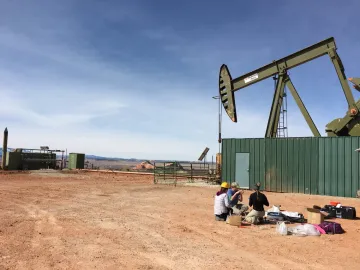NSF Awards HAS Professor Jen McIntosh and her UArizona-Led Team $2.8 Million to Study How Subsurface Fluids, Microbes, and Rocks Interact and Evolve Over Time

Congratulations to HAS Professor Jen McIntosh on receiving a new $2.8 Million NSF grant to study how subsurface fluids, rocks and microbes interact and evolve over time.
You can read the original article by Mikayla Mace Kelly, University Communications, here. An excerpt of the article follows.

Jen McIntosh's students Jihyun Kim and Chandler Noyes, with Rebecca Tyne, University of Oxford, collect fluid samples from an 8,500 deep oil well in the Lisbon Valley near Moab, Utah
Scientists still have much to learn about how water and other fluids flow thousands of feet beneath Earth's surface and how this influences microbial life below. Perhaps surprisingly, we know more about the surface of Mars than we do about water and life in the depths of our own planet.
The National Science Foundation Frontier Research in Earth Sciences, or FRES, program awarded a University of Arizona-led team $2.8 million to study how subsurface fluids, rocks and microbes interact and evolve over time. The project has been dubbed SMRFS, short for Subsurface Microbe-Rock-Fluid Systems, which was meant to evoke images of little blue Smurf miners.
Jennifer McIntosh is the lead Principal Investigator of the project. Pete Reiners, a professor in the UArizona Department of Geosciences, is a Co-Principal Investigator.
The team hopes to learn how changes to the Earth's surface over its history affected the underground biosphere, what geologic and climate factors favor or limit the potential for subsurface microbial life, and what the rock record says about the history of microbial life and its relationship with fluids and fluid-rock reactions.
McIntosh and her team also want to understand how life existed deep underground tens of millions of years ago. The team will focus the study on the Paradox and Rio Grande Rift basins in the southwestern United States and, ultimately, create a guide for looking for life in the subsurface throughout geological time.
"We want to make a predictive model for the past," McIntosh said. "At the end, we're hoping to say, 'In this subsurface location, at this time, we would expect life could have survived.'"
Read more about this exciting research project at the UArizona News website.
Congratulations, Jen! What an amazing project for you and your students!

